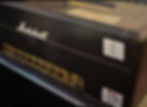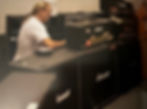Gear Spotlight: Hetfield’s 1973 Jose Modded Marshall Super Lead
- Silverwulf
- Dec 26, 2023
- 6 min read
Stories of legendary and iconic amps used by artists on popular studio albums go back to the earliest days of rock music. Eddie Van Halen‘s Marshall Super Lead, the modded S.I.R. Marshall used by Slash with Guns N’ Roses, and one near and dear to our hearts here at Metallica Gear History and Analysis - the Mesa Mark IIC+ “Crunchberries” and James Hetfield. Sometimes the amp itself achieves a mythical status independent of the artist that used it.
In this Gear Spotlight, we’ll discuss James Hetfield's 1973 Marshall (Jose Modded) Super Lead.
Admin Note: Join our new Facebook group to stay notified when new articles are published:
https://www.facebook.com/groups/691552878652326/

THE HISTORY
Back in 1989, producer Bob Rock was in Little Mountain Sound Studios in Vancouver, Canada tracking a new album - Dr. Feelgood - with Sunset Strip favorites Motley Crue. It was his first album with the band, as well as his first time working with guitarist Mick Mars.
As guitar tracking commenced, one amp in particular stood out - a late 1973 Marshall Super Lead (1959, 100W) head unit owned by Mars that was rather unique. The amp, responsible for a lion’s share of the guitar tone on Dr. Feelgood, was modded by legendary tech Jose Arredondo.
This particular amp had a basic “3-in-1” mod, as noted by Jose amp “historian” Dave Friedman of Friedman Amps. It is a relatively low gain affair by modern standards, with an extra tube gain stage added in front of a stock Super Lead circuit using a post-EQ master volume. It contains no clipping diodes and retains an all-tube signal path with circuit tweaks individualized for Mars.
Bob Rock, a self-proclaimed “collector of tones,” was impressed by the sound and wanted to have a similar amp in his own collection. This was common for Rock, who routinely bought copies of amps and rigs that mirrored the gear used on albums he produced. He acquired Arredondo’s contact information from Mars and set out to have an amp modded in the near future.

Bob, never shying away from encouraging others to buy and collect gear, would subsequently push Hetfield and Hammett to acquire Jose modded amps of their own as production was starting on Metallica (Black Album). This is a trend that continued all throughout the 1990s, with Hetfield and Hammett amassing large vintage guitar and amplifier collections as a result. When production started on Metallica (Black Album), all three of them sought out a new Jose modded Marshall to call their own.
The Jose Modded Marshalls
Bob, James, and Kirk all requested an amp that suited their desired tastes and playing style. Bob was a vintage tone stylist at heart, preferring the sound of the cranked Marshalls of yesteryear. His direction for Jose shied away from the ultra gain, super bright tones of the era. Instead, he asked for a mod that was not overly “gained up,” with a warm sound and midrange character.
As tracking for Metallica (Black Album) commenced, Bob and James took possession of their newly modded amps. Kirk, however, was still in queue and awaiting his. Jose had fallen ill by this time, and the modifications had started to take progressively longer.
Jose passed away peacefully in September 1994, leaving behind 100s of amps that were never returned to their owners which were sent to him for maintenance or modifications. Hammett would never receive his Marshall.

HETFIELD'S 1973 JOSE MARSHALL
James received his modded Marshall back from Jose, but didn't originally feel it turned out as well as Bob's Marshall.
The Marshall that James sent in for modding was a 1973 Marshall Super Lead (1959, 100W) head unit. This was a transitional year for Marshall, with subtle tweaks occurring in the Super Leads and them moving away from hand wired amps and over to print circuit boards (PCBs).
1990s - The Early Years of the Mod
The original mod that Hetfield received as identical to that of Bob Rock (and Mick Mars). It was a typical "3-in-1" Jose mod that included the following:
3-in-1 Jose Modification
Tube Gain Stage Added in Front
Gain Knob for the Extra Gain Stage
Post-EQ/Tone Stack Master Volume
Pull Switch to Engage Extra Gain Stage
Pull Switch to "Jump" Bright & Normal Channels
NO Clipping Diodes
With no clipping diodes added, Hetfield's Marshall retained an all tube signal path and was a low to moderate gain amp compared to modern high gain heads. The bass and low end is dialed back in both the amp and extra gain stage, leading to a smaller bass response overall in the amp, but a rich character to the texture and resoonse.
In addition to the standard changes, this original iteration of the mod included some odd changes preformed by Jose. Perhaps spurred by the notion that Metallica was a metal band, the amp had a 200W output transformer swapped on and was converted to use KT88 tubes.
Never being satisfied with the tone of the amp, and feeling it was inferior to Bob's Marshall, Hetfield's Marshall was essentially stored away for the majority of the 1990s while Bob's Marshall was used on Metallica (Black Album), Load, Reload, and Garage Inc.
James would not bring the Marshall out again until the late 1990s, attempting to try it again and make it usable.

Early 2000s - A Second Chance
As the 2000s came around, Hetfield seemed determined to use the Marshall and make it a usable part of his studio backline. When writing commenced for the St Anger album, Metallica moved into the U.S. Army barracks in San Francisco around 2001 for what is frequently called the "Presidio" sessions.
Loading in massive amounts of gear and starting to write new material, Hetfield had the 1973 Marshall by his side during the initial writing sessions, determined to make it work for the new material.

Despite his best efforts and attempts to make it usable, Hetfield's Marshall simply wasn't up to par, with Bob's Jose Marshall outshining it and being used on St Anger, just as it was for every album since Metallica (Black Album).
Admitting defeat, James would once again store the Marshall away where it would remain dormant for nearly 2 more decades. By the 2020s though, the amp was about to see new life breathed into it. Enter Dave Friedman.
2020s - Restoration & 72 Seasons
After decades of sitting idle, producer Greg Fidelman ran across the 1973 Marshall at Metallica HQ. As James lamented that he didn't have a "signature" Marshall that was all his own, much the way Kirk loved his 1979 Marshall JMP 2203, Fidelman decided to try and get the Marshall functional again.

The amp was sent to Dave Friedman of Friedman Amplification, and he set to work getting the amplifier restored for Hetfield.
Dave restored the amp back to its former glory, included swapping out the 200W output transformer for a 100W model as it was stock, and converting the amp away from KT88s and back to EL34s.
The final and current day spec of the amp is:
3-in-1 Jose Modification
Tube Gain Stage Added in Front
Gain Knob for the Extra Gain Stage
Post-EQ/Tone Stack Master Volume
Pull Switch to Engage Extra Gain Stage
Pull Switch to "Jump" Bright & Normal Channels
NO Clipping Diodes
100W Output Transformer (200W Removed)
EL34 Power Tubes (KT88s Removed)
The amp came back from Friedman, and Hetfield was ecstatic. Fully restored and sounding better than it had in 30 years, it quickly became a studio favorite for James, being used as one of the primary amps on every track on 72 Seasons. The midrange character and overtones can clearly be heard all throughout the album.
Hetfield's Jose Modded 1973 Marshall Super Lead (1959, 100W) may have gotten off to a slow start, but it finally found its place after James owning it for over 30 years. It seems to be here to stay, becoming a studio favorite and earning top billing in Hetfield's backline.
The amp isn't high gain by modern standards. It's moderate gain, with a small bass response by design with no clipping diodes or extra features. However, it's midrange character and overtones make it an undeniable and instantly recognizable part of Hetfield's current tone.
If there are aspects of 1973 Marshall not covered here that you’re curious about, please leave a comment or send a message. We can edit the article to include additional information if there is a demand for it.
Also, please check out our other articles for a detailed analysis on other Metallica gear, album breakdowns, and more. Thanks for reading!
